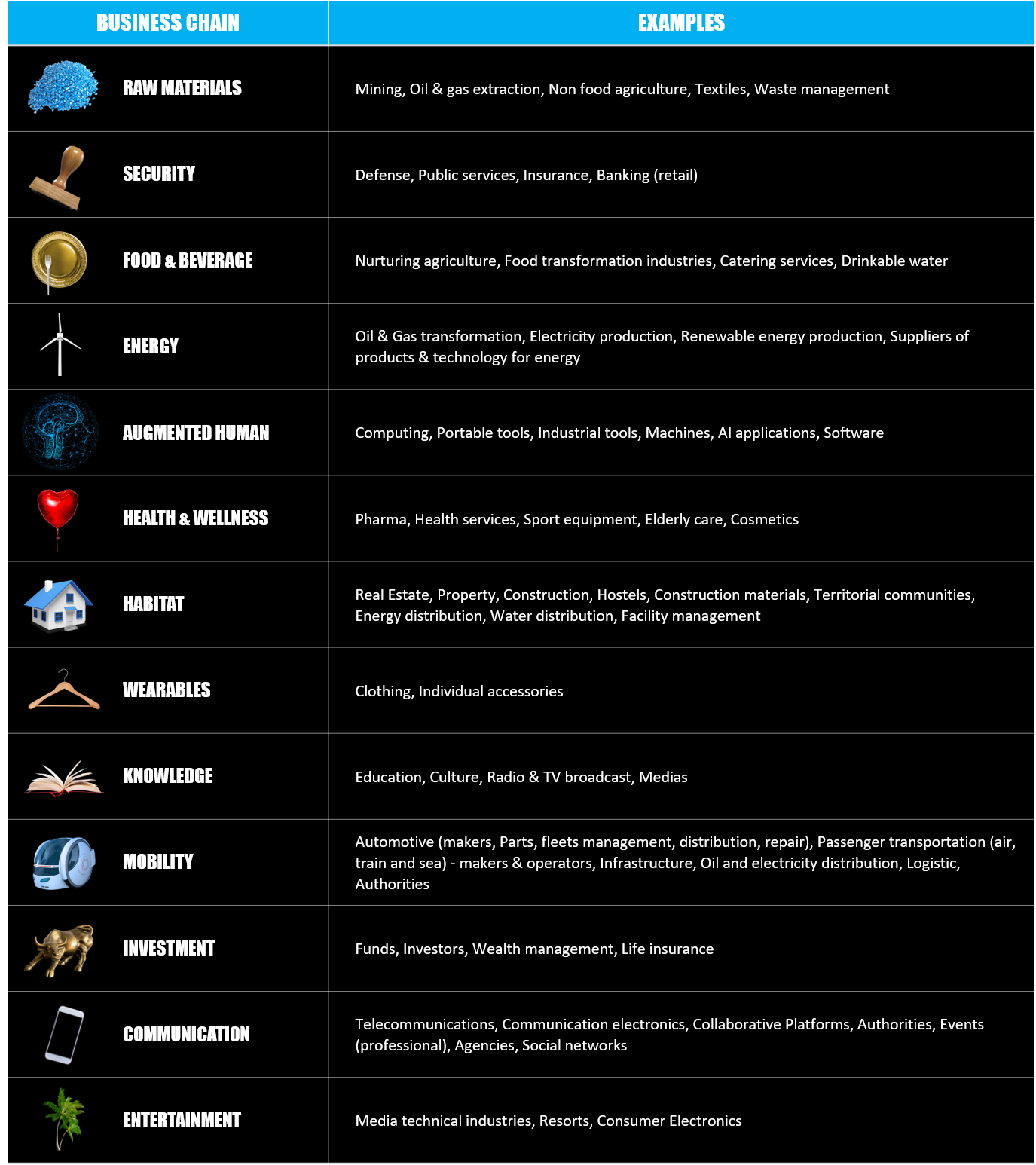- Knowing where you’re starting from
- Thinking recovery beyond the company’s borders
- Don’t assume that everything will change or that everything will be as it was before
- Take into account the psychological impacts of containment
- Integrate a new decision-making Framework
We also invite you to share this analysis during a webinar to be held on May 5th from 10 to 11 am.
Chapter 2: Thinking recovery beyond the company’s borders
Highlighting the extreme imbrications of business chains
Thus the business chains are more intertwined than ever before and the crisis has served to highlight their close links.
The impacts on companies are linked to the impacts on the other players in their business chain
For the Executive Boards today, taking the full measure of the business chain concept is a first key to analysis in order to measure the impacts and imagine the revitalisation of activities. With the confinement, and highly differentiated impacts from one country to another when one carries out a globalized activity, it is a question of becoming aware that this new organization of work imposed is all the more efficient as the targeted actions will be carried out by business chain and by activity. Cooperation will be all the more essential (cooperation between stakes of activity to bring out the business chains and the professions within the business chains). If each company in the chain is not impacted in the same way, first of all, on the more or less great slowdown of its volume of activity, but also and above all on the behaviour of another player in the business chain, it is not impacted in the same way in relation to its subsidiaries abroad, which may adopt different methods of containment.
By way of illustration, the Robert Schuman Foundation has summarised the various containment measures taken by European states.
It is interesting to note that the main cause of the decrease in business activity, according to a report “Activity and employment conditions of the workforce during the Covid-19 health crisis” made in France by the governmental agency DARES, is overwhelmingly (85%) due to “loss of outlets, administrative closures, or supply difficulties” and much less (15%) to “a lack of staff able to work “*. It is therefore in relation to its supply chain business ecosystem upstream (supply difficulties) and downstream (loss of outlets) that a company is affected. If a sector such as the manufacture of transport equipment has seen its activity decline very sharply or be stopped at 92%, it is not so much because of difficulties in organising its factories to maintain a minimum production level while respecting the safety of workers, but rather because of the combined effects of supply difficulties upstream and the cessation of activity of transport operators downstream. One could have imagined that a company taken in isolation would take advantage of this to work on projects (e.g. optimising its production chain), continue to produce a little to build up a reasonable stock of products, but the economic intertwining with its business chain makes this scenario too costly and risky.
*Source : [FRA] Dares, enquête Acemo Covid, avril 2020
Thinking of its activity through its business stake and no longer through sectors and professions
A self-centred vision would be pointless for company managers, what is the point of maintaining an activity, even a partial one, if others in the same business chain do not do so? Even if stocks can allow an activity to continue with a reduced replenishment for a few weeks, a disruption upstream or downstream of the chain does not fail to have an impact on its own activity after a certain period of time.
On the contrary, we defend a vision by business chain and not by industry sector. To minimise the impact, the key to recovery is the adoption of public actions and solidarity actions by business chain and not by sector (helping just one of the players in a business chain is useless), where in the end value creation will be highest. The example of the EU 240 billion granted in the form of loans exclusively to the health business chain illustrates this point. The next step for a successful relaunch would be to continue and structure support measures on a chain-by-chain basis, activating new forms of cooperation and solidarity between actors in the same business chain, and focusing support measures on the key actors in the chain to promote recovery (e.g. the supplier at the beginning of the chain on which downstream actors depend).
Integrate the public player in its decision-making frame of reference
Numerous emergency measures have been taken by public actors around the world to help the economy absorb the economic impact as well as possible. States, Central Banks or supra-state institutions such as the European institutions have multiplied the measures of subsidies, financing, direct and indirect, at the service of companies.
As these tables from the Robert Schuman Foundation illustrate, the recovery measures at European level and taken by the various Member States are numerous and have been constantly reinforced since the beginning of the crisis to support businesses.
State interventionism in liberal economies in times of crisis is not new. Its role has been affirmed during the various economic crises that liberal capitalism has gone through, from the stock market crisis of 1929 to the debt crisis in the euro zone (2010-2013), the stock market crash of 2001-2002 and the financial crisis of 2008. Measures to support large companies and especially banks and financial institutions have been numerous. If the current crisis sees the implementation of similar support measures, does public interventionism seem to go further? Public actors are helping small businesses and independent entrepreneurs who have been hit as hard, if not harder, than large groups, who have financial reserves that allow them to absorb a decrease in income for longer and who are not affected in their financing methods as in the financial crises mentioned above. Economic links between companies and public players are no longer reserved for large “Too big to fail” companies.
In addition to one-off measures, there is also a willingness on the part of public players to intervene on a long-term basis in the creation of new financial capacities for companies. Although cautiously, the French State does not fail to speak of nationalisations and proposes to “protect companies for a limited period of time by taking a stake or possibly by making a temporary nationalisation” (Bruno Le Maire, Minister of the Economy and Finance, France 24 and RFI, 3 April 2020). Regarding the industrial production of the pharmaceutical industry, a sustainable reindustrialization of drug production in France will be a priority issue for the State (speaking of the pharmaceutical industry, “We will have the opportunity to come back to the essential issue of reindustrialization”, Olivier Véran, Minister of Solidarity and Health, National Assembly, 31 March 2020).
Highlighting the strong links of dependence on production imported from abroad on entire business chains encourages public actors to take real measures on the subjects of reindustrialisation and relocation of the national productive fabric, all the more so as these ideas have been in the air for some years now and are gaining strength in public opinion (especially for questions of reducing carbon emissions due to freight).
In their rebound strategies, companies will therefore have to take into account, in addition to the players in their stake, the public players in their decision making reference frameworks. The interventionist willingness of public authorities, which is bound to last after the crisis, and their ability to finance and legislate make them key agents for a sustainable recovery.
The business chains evolve together, according to the innovations and the activity of each player in the chain
How to understand the interrelationships between your company and the players in your business chain(s)? What can you do to organise the restart by business chain? How to integrate the public player in its future strategy? What opportunities for innovation and operational excellence can be put in place to not only organize the restart but also become more efficient than before the crisis?
Follow our news and join us on 5 May 2020 from 10 to 11 am for a webinar dedicated to this topic!

